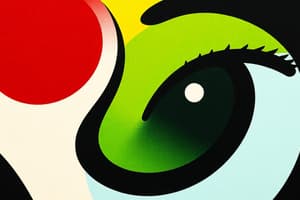Podcast
Questions and Answers
What are binocular cues?
What are binocular cues?
- Cues that only depend on one eye
- Depth cues that depend on the use of two eyes (correct)
- Cues based on movement
- Distance cues available to one eye
What is convergence?
What is convergence?
The extent to which the eyes converge inward when looking at an object.
What does retinal disparity refer to?
What does retinal disparity refer to?
The greater the disparity between the two images the retina perceives of an object, the closer the object is to the viewer.
Which of the following describes monocular cues?
Which of the following describes monocular cues?
What is interposition?
What is interposition?
What does relative size indicate?
What does relative size indicate?
What does relative clarity imply?
What does relative clarity imply?
What is texture gradient?
What is texture gradient?
What does relative height refer to?
What does relative height refer to?
What does relative motion denote?
What does relative motion denote?
What is linear perspective?
What is linear perspective?
How does light and shadow contribute to perception?
How does light and shadow contribute to perception?
What is selective blindness?
What is selective blindness?
What does perceptual adaptation mean?
What does perceptual adaptation mean?
What is a perceptual set?
What is a perceptual set?
What is the context effect?
What is the context effect?
What is extrasensory perception (ESP)?
What is extrasensory perception (ESP)?
What is telepathy?
What is telepathy?
What does clairvoyance mean?
What does clairvoyance mean?
What is precognition?
What is precognition?
What is parapsychology?
What is parapsychology?
What is psychokinesis?
What is psychokinesis?
What is the Ganzfield procedure?
What is the Ganzfield procedure?
What is the absolute threshold?
What is the absolute threshold?
What is sensory adaptation?
What is sensory adaptation?
What is the difference threshold?
What is the difference threshold?
Where does transduction take place in the ear?
Where does transduction take place in the ear?
Brightness is to intensity as hue is to __________.
Brightness is to intensity as hue is to __________.
What is the cocktail party effect?
What is the cocktail party effect?
What happens to the perception of size when watching someone walk away?
What happens to the perception of size when watching someone walk away?
What is perceptual adaptation in the context of reading upside down?
What is perceptual adaptation in the context of reading upside down?
What type of ESP allows someone to read minds?
What type of ESP allows someone to read minds?
What term refers to mental predispositions influencing perception?
What term refers to mental predispositions influencing perception?
Which perspective of psychology emphasizes that the whole exceeds the sum of its parts?
Which perspective of psychology emphasizes that the whole exceeds the sum of its parts?
What are the receptor cells that convert light energy into neural signals?
What are the receptor cells that convert light energy into neural signals?
What is parallel processing?
What is parallel processing?
On a cloudy day, a yellow flower is likely to appear ______ as it does on a bright day.
On a cloudy day, a yellow flower is likely to appear ______ as it does on a bright day.
What is the rate at which impulses travel up the auditory nerve matching?
What is the rate at which impulses travel up the auditory nerve matching?
Flashcards are hidden until you start studying
Study Notes
Binocular Cues
- Binocular cues are depth perception signals that require both eyes, including retinal disparity and convergence.
- Convergence refers to how much the eyes turn inward to focus on an object, indicating its proximity.
Retinal Disparity
- Retinal disparity is the difference in images received by each eye; greater disparity indicates closer objects.
Monocular Cues
- Monocular cues are depth cues available to one eye, including linear perspective, overlap, and relative size.
Interposition
- Interposition occurs when one object partially blocks another, signaling that the blocked object is farther away.
Relative Size
- Relative size indicates that objects of the same size appear smaller when they are further away.
Relative Clarity
- Hazy objects appear more distant due to reduced clarity, reflecting atmospheric effects on perception.
Texture Gradient
- Objects further away lose texture detail, transitioning from distinct to indistinct texture, signaling increased distance.
Relative Height
- Objects positioned higher in the visual field typically appear larger compared to those at lower positions.
Relative Motion
- As we move, stable objects appear to move in the opposite direction, providing cues about distance.
Linear Perspective
- Parallel lines appear to converge as they recede into the distance, influencing depth perception.
Light and Shadow
- Nearby objects reflect more light, appearing brighter, while dimmer objects suggest greater distance.
Selective Blindness
- Selective blindness is the failure to notice an unexpected stimulus due to a lack of attention.
Perceptual Adaptation
- Perceptual adaptation is the ability to adjust to an altered visual field, such as blurred or inverted images.
Perceptual Set
- A perceptual set is a mental predisposition that influences how we interpret sensory information.
Context Effect
- Context effects involve interpreting stimuli based on prior knowledge or context, affecting perception.
Extrasensory Perception (ESP)
- ESP refers to claims of perception occurring without sensory input, including phenomena like telepathy and clairvoyance.
Telepathy
- Telepathy is the ability to communicate thoughts between minds without verbal or physical interaction.
Clairvoyance
- Clairvoyance involves perceiving events or information from a distance without direct sensory input.
Precognition
- Precognition is the claimed ability to foresee future events, often linked to paranormal phenomena.
Parapsychology
- Parapsychology studies paranormal phenomena, including ESP and psychokinesis, exploring human capabilities beyond normal senses.
Psychokinesis
- Psychokinesis refers to the ability to influence physical objects or events through mental power alone.
Ganzfield Procedure
- In the Ganzfield procedure, one person is blinded while another attempts to guess what the first is seeing, testing ESP claims.
Absolute Threshold
- Absolute threshold is the minimum stimulus intensity that can be detected more than 50% of the time.
Sensory Adaptation
- Sensory adaptation explains why we may stop noticing stimuli, like heat, after prolonged exposure.
Difference Threshold
- The difference threshold is the smallest detectable difference between two stimuli, impacted by intensity and perception.
Cilia
- Cilia in the ear are crucial for transduction, converting sound vibrations into neural signals for processing.
Brightness and Hue
- Brightness correlates to intensity, while hue relates to the wavelength of light, defining color perception.
Cocktail Party Effect
- The cocktail party effect describes the ability to focus on a specific conversation while filtering out background noise.
Relative Size (Reiteration)
- Objects appear smaller when further away, even if their size remains constant, highlighting perceptual bias.
Perceptual Adaptation (Reiteration)
- Adaptation to visual changes, like reading upside down, showcases the brain's flexibility in perception.
Telepathy (Reiteration)
- Telepathy is recognized as a form of ESP that allows thought communication without verbal expression.
Perceptual Set (Reiteration)
- Perceptual sets shape our experiences, influencing what we prioritize and recognize in our surroundings.
Gestalt Psychology
- Gestalt psychology emphasizes that perception is holistic, asserting that the whole is greater than the sum of its parts.
Rods and Cones
- Rods and cones are photoreceptor cells that convert light energy into neural signals, critical for vision.
Parallel Processing
- Parallel processing enables simultaneous perception of multiple characteristics like movement, color, and shape.
Color Perception on Cloudy Days
- A yellow flower appears consistently bright on cloudy days as it would on sunny days due to color constancy.
Auditory Impulse Matching
- The auditory nerve transmits impulses that align with the frequency of sound waves, facilitating accurate hearing perception.
Studying That Suits You
Use AI to generate personalized quizzes and flashcards to suit your learning preferences.




